
This article was originally published on avocadoposts.com and has been republished here with permission.
Have you been suffering with houseplants and are ready to give up? Give this article a chance, these pointers will undoubtedly assist you in correcting a few errors while also motivating you to continue to improve! Many houseplants die as a result of minor errors like inadequate drainage, too much sun, bad soil, or insufficient water. You can avoid dreaded houseplant deaths by making easy changes to your houseplant care.
Caring for your indoor plants
There are a few tricks for keeping your orchids thriving. Place them outside to absorb some extra sun energy, because light is food for plants. People frequently fail with houseplants because they’re unaware of how gloomy it’s inside or how light-dependent plants are. But, how do you determine if your plant is receiving sufficient light? There’s fresh growth with larger and more durable leaves than preceding ones. The leaves turn a crimson or purple color (some plants). The plant isn’t losing leaves, and is developing rapidly and steadily.
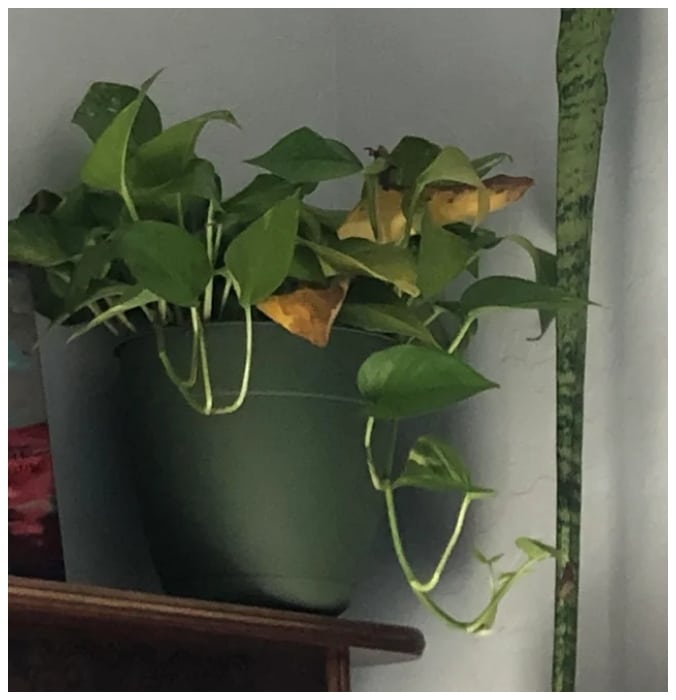 reddit.com
reddit.comThe main cause of spindly growth and leaf drop is a lack of light. That doesn’t rule out other alternatives, but it does make this the most important one. Light is food, thus plants that receive less light drop their leaves, much like we humans do when we eat less. If you follow this advice, you’ll be on your road to success.
Light
There is no such thing as a “low light” plant. Light is an important source of nutrition for plants. As a result, they require as much sunlight as possible to fully thrive. You should also consider the origins of your plant species. Different plants come from various places of the world and require specific amounts of light. Succulents, cactus, and begonias, for example, come from lighter locations in their natural environment and require a lot of direct sunlight indoors.
 SCFGallagher / tendergardener.com
SCFGallagher / tendergardener.comSubsequently, you will want to put them in the brightest window you have. Plants such as a Birds Nest fern or a Boston fern, need more shady areas. And, while it may seem obvious, the larger the plant becomes, the more light it requires. So, while a plant may begin on an end table with some indirect sunlight, as it grows, it may need to be moved closer to the window.
Water
When it comes to succulents, remember to water when the soil is dry. To make sure you’re not over- or under-watering your plant, take into consideration the following tricks. Don’t keep track of the days in between waterings. Every few days, check on your soil or whatever you’ve placed it in. You can irrigate the soil if it is dry. Depending on the season, certain plants may need to be watered every few days, every week, or even every two weeks.
 plantcaretoday.com
plantcaretoday.comif it’s moist and stinks, it’s too wet, and your plant is starting to decay; if it’s bone dry and dusty, you should water it. There is a correct method for watering a plant. First and foremost, always use warm water since most houseplants aren’t from cold climates, and warm water seeps more quickly into the soil. Also, make sure your watering stream is aimed at the plant’s base.
Signs of trouble
Diagnose your plant holistically in order to figure out what’s wrong with it. Do the leaves appear to be falling or turning yellow? How does the dirt feel? Here are some red flags to keep an eye out for. The roots will start to decay when you overwater it. If the edges of the leaves begin darkening, it might mean that they are being eaten away by a fungus. When leaves turn yellow, it’s a cautionary sign. It could be too hot, too cold, too wet, or too dry, which is why you should always be on the lookout for secondary symptoms.
 mygardenlife.com
mygardenlife.comWrinkled or drooping leaves indicate that your plant is dehydrated and needs to be watered. If leaves begin to fall off, it’s mostly due to lack of light. For plants, light is their source of nutrition. The remedy is to place them in front of a bright window.
Aerate soil with a chopstick
Over time, you’ll notice that plant soil becomes compacted. Gently poke a chopstick or pencil into the soil to loosen it up again, allowing roots, water, and oxygen to do their jobs. Two pokes per inch of pot diameter is a fair rule of thumb.
 youtube
youtubeAs a result of the lack of earthworms, the soil health of your potted plants is dependent on how you keep its structure in balance. As plant roots collect water on a regular basis, the dirt becomes increasingly compacted. When the soil doesn’t hold water as well as it used to, it’s time to aerate.
Use a chopstick to support leaning plants
You may use the wooden chopsticks from your takeaway as miniature plant stakes if your plants require a little stability as they grow: Secure them in the soil and tie your sagging stems up with plant tape or twine. Wood, wire, rattan, and bamboo all make great supports for climbing houseplants as well.
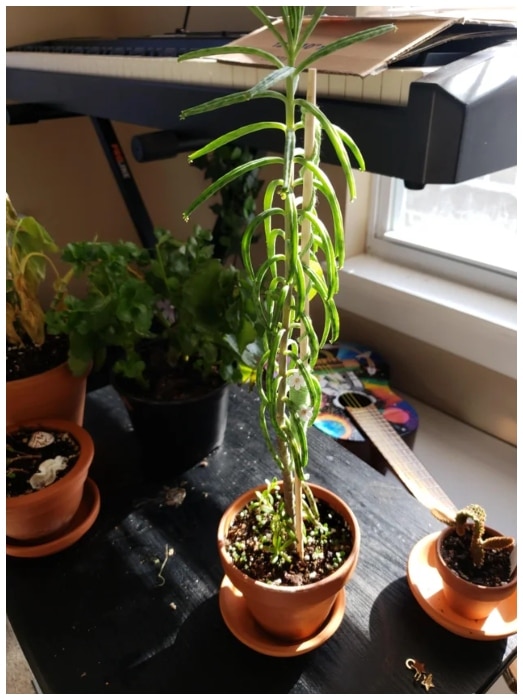 reddit
redditYou can get a trellis, spindle, and even round arches. If you are skilled enough, you can always make your own with a couple of chopsticks. This is a great way to repurpose waste that would otherwise end up in a landfill, and be more environmentally conscious.
Slow-release houseplant fertilizers
Likewise referred to as time-release fertilizers, slow-release fertilizers for indoor plants are created using a synthetic supply of nutrients. A covering surrounds the liquid nutrition of the dragee.
 savvygardening
savvygardeningThis coating degrades gradually and releases the nutrients over time in small doses. You will need to fertilize less regularly if you use products like these. Although it’s quite practical, keep in mind that they are not produced using environmentally safe materials.
Group humidity-loving plants together
As you may know, plants, too, require companionship. But, more crucially, your humidity-loving plants will all emit moisture, which will benefit surrounding plants. This is how it works: by grouping your humidity loving plants together they can help each other out by making the general area around them more humid.
 bloomscape.com
bloomscape.comThis happens because their leaves, stems, and flowers transpire and it leaves a cooling effect on the air. As a styling tip, group plants together that have a similar shade and design so they don’t clash. This is another way of taking the most advantage of your houseplants during summertime.
Steps to splitting a snake plant
Turn the potted plant over so that it is lying on its side. After that, lightly tap the edges to free it from the saucepan. After removing the plant from its container, you should untie the roots from the dense bundle. Look for the stems’ bulbous base.
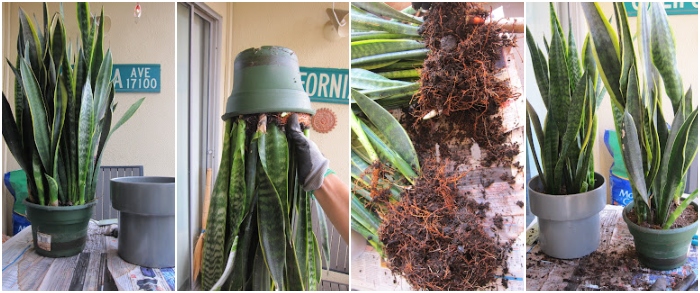 oakleysgarden
oakleysgardenPull the bundle’s complete stems apart slowly. Now you ought to possess two bundles. Each bundle should be put in its own pot.
Cut a corner off a sponge and designate it as your plant duster
Dusting the leaves of plants can assist them in photosynthesizing to their full potential. To make the leaves sparkle, dampen the sponge slightly and brush it over them while avoiding scratching the leaves. Make a solution with 1/4 teaspoon dish soap per quart of tepid water, then dip your sponge into it until it’s damp.
 youtube
youtubeWipe off the leaves in a soft manner with a damp sponge until they appear clean, rinsing the sponge frequently to avoid spreading dirt. To differentiate your plant sponge from the ones you use on the dishes or the bathtub, cut a corner off.
Water plants with your overnight drinking water in the morning
Another useful hack: in the morning, use the drinking water left on your nightstand to water some of your plants. Leave a container of water sitting on the side to evaporate off the chlorine in tap water until it is plant safe. Then water your houseplants with it in the morning.
 youtube
youtubeYou should do this for at least 24 hours before using the water for plants, and for longer if you have a large container. Cold pre-boiled tap water is also good for plants because it is an effective method to reduce the calcium that is present in the water.
Use hard-boiled egg water to water your plants
Eggshells are naturally high in calcium, which aids in soil pH neutralization. This is mainly because the calcium carbonate slightly increases the pH of the soil. When you hard-boil eggs, a small amount of calcium is released into the water, which your plants may appreciate for extra nourishment.
 cookist.com
cookist.comPlease make sure that you let the water return to room temperature before you add it to your plants’ soil. Additionally, you are doing something beneficial with water that would otherwise be wasted. This is a great alternative if you do not have the space or time to develop a compost pile.
Water plants with bathwater
There is no harm in using water from the bath to water your plants so long as they are not edible (and no pets or kids could chew on them). If you use Epsom salt in the water, your plants will appreciate it, but if the water contains additives such as colors or scents, you will want to avoid it.
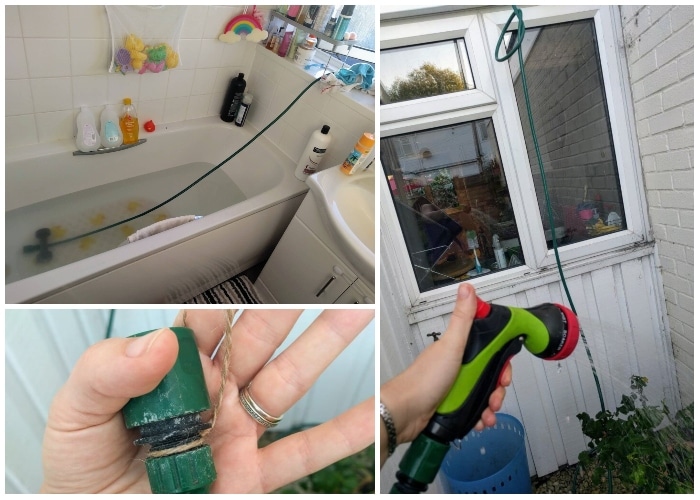 lifeasmrsd
lifeasmrsdSoapy water can benefit plants, particularly in controlling certain insects, but it is important to ensure that the soap product you use does not have additives that are harmful to plants and that you dilute it sufficiently to avoid damage.
Water with an Epsom-salt solution
Plants require magnesium and sulfur, and happily, both of these elements are present in Epsom salt, which is made of hydrated magnesium sulfate. To stimulate bushier, more flowering plants, mix two tablespoons of Epsom salt into a gallon of water and water your houseplants with it.
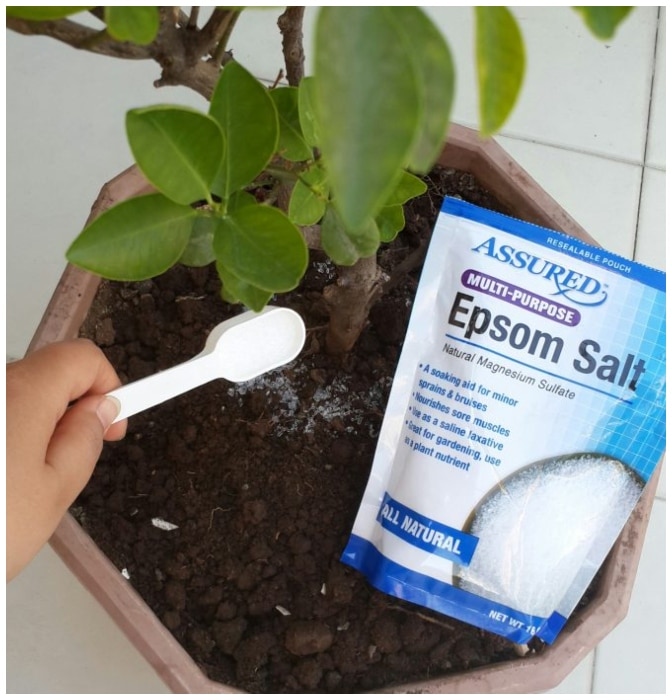 blog.nurserylive.com
blog.nurserylive.comHowever, excessive levels of magnesium sulfate can cause salt injury to plants. Roses, pansies, petunias and impatiens are particularly fond of Epsom salt water! You can sprinkle Epsom salt directly on the soil, if it becomes depleted of magnesium. This household product can be bought at the supermarket or drugstore for little money.
…Or just use it as a mist
Another option to give your plants a nutrient uplift is to sprinkle them with an Epsom salt solution. For potted plants, simply dissolve two tablespoons of Epsom salt per gallon of water, and substitute this solution for normal watering once a month. Begin spraying an Epsom salt solution on your vegetable plants when you see blooms first appear.
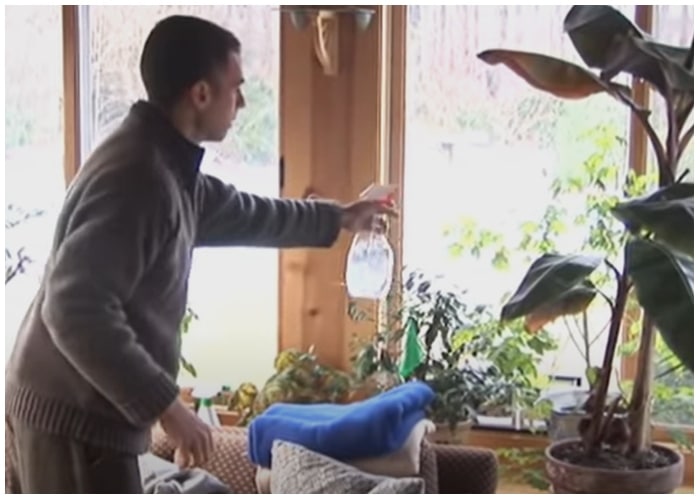
This solution will aid tomato and pepper crop yields and keep the plants looking green and bushy. When soil deficiencies occur, tomato and pepper plant leaves turn yellow between the veins late in the season, and fruit may be slow to ripen.
Make a vertical garden from an IKEA bag holder
Do you live in a small place with not much extra room for pots but you still want to have plants? Reconsider your position. The VARIERA bag dispenser from IKEA can be transformed into a wall garden with some moss and soil. To maximize space for growing succulents, flowers or even strawberries, fill the bag holder with moss and dirt and use it as a planter.
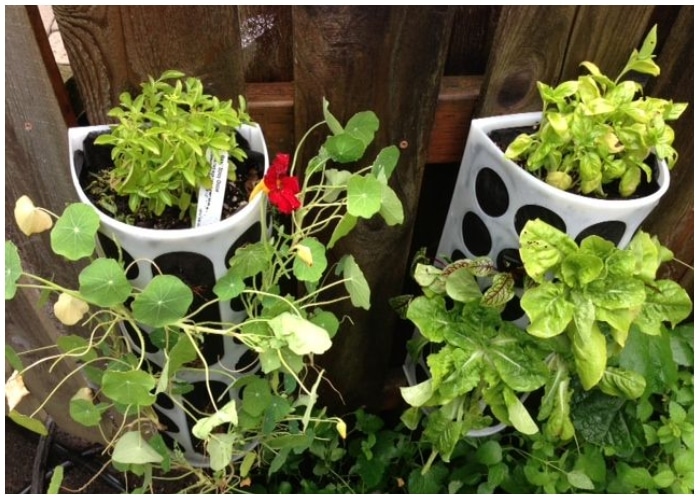 pinterest
pinterestYou can turn it into a vertical garden, which is a vertically hanging panel where hydroponically grown plants are produced. These one-of-a-kind structures can be mounted to a wall without occupying any extra space.
Houseplant Fertilizer Basics: How And When To Feed Houseplants
Rather than waiting for a signal from the plant, fertilize your houseplants on a schedule that corresponds to their growth cycle. When it comes to houseplant fertilizer levels and frequency, each plant has somewhat varied requirements. Some houseplants require more food than others. However, a houseplant fertilizer regimen like the one shown below strikes a fair compromise between satisfying heavy feeders and preventing you from overfeeding houseplants that require less fertilizer.
 savvygardening
savvygardeningFertilize houseplants about 8 weeks before the last spring frost is forecast. The frequency with which you apply summer fertilizer is determined on the type of fertilizer you’re applying. Reduce the amount and frequency of houseplant fertilizer about 8 weeks before the first forecast fall frost. Because plants are not in an active growth phase throughout the winter, they should not be fertilized.
Regrowing pineapple top in water or soil
Pineapple tops make great houseplants! First twist the pineapple top off the fruit, then peel off about 4 rows of the lower leaves to expose the stem. Let it dry and cure for 3-5 days, and put the pineapple top in water.
 apieceofrainbow
apieceofrainbowTo bear fruit, pineapples require two years of growth along with plenty of heat and sunlight. However, growing them even as houseplants may be quite enjoyable and gratifying.
Plant care cheat sheet
Before you buy a plant at the store, make sure to thoroughly inspect it for possible damage. Always re-pot your plant after buying. Go about an inch or two larger than the plastic pot that they’re in, so it has enough room to grow. Add some fertilizer if you consider it necessary. Next thing you need to do before bringing the plant inside the house and place it among the other plants is to debug it and quarantine it.
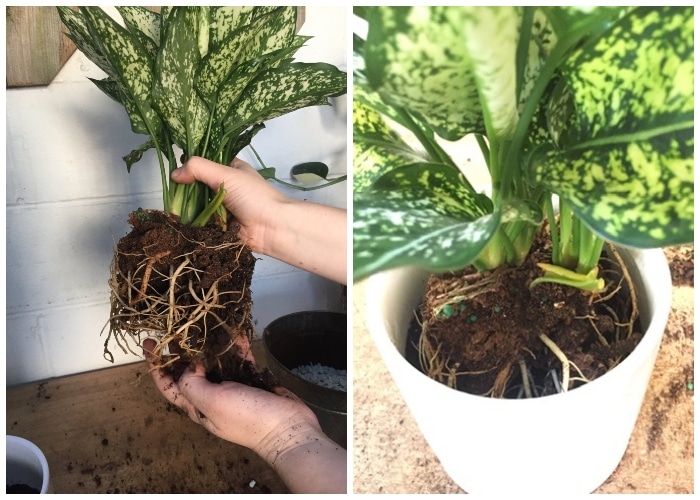 nicheplantshop.com
nicheplantshop.comWhen potted indoor plants are outside, aphids, mealybugs, and other sorts of houseplant insect pests can be brought inside and infect the rest of your houseplants. Remember that there are no “low-light” plants; all plants require direct sunshine or bright spots. Sunlight is an important component in your plant’s nutrition. And finally, always follow nature’s lead and only water when the soil is completely dry, then soak it from the bottom.
How To Propagate A Fiddle Leaf Fig In Water
Taking a cutting is the first stage in propagating your tree. Generally, you should select one of the plant’s healthiest leaves or stems and use it. Regardless of whether you choose a stem or a leaf, make sure that a “node” is attached. Your plants will take root at the node. To make the cuts, use a clean, sharp pair of scissors. Before you put your plant in water, dip the end of it in some rooting hormone.
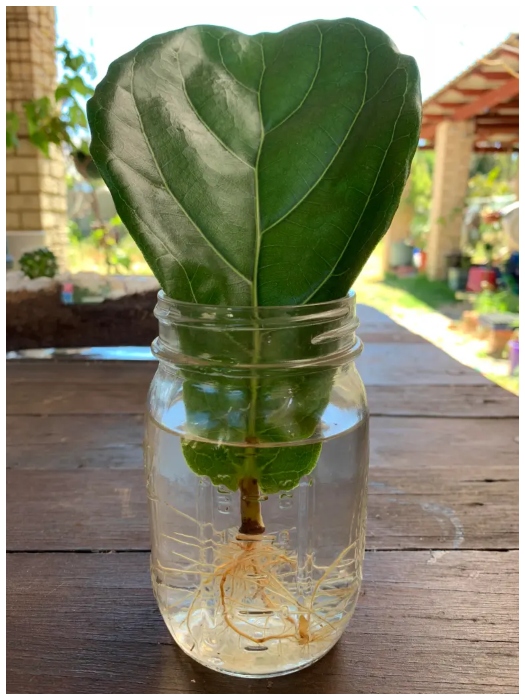 indoorplantcare
indoorplantcareFill a glass jar halfway with water and add the fiddle leaf fig. Water should only be used to cover the bottom few inches of the stem. Leaves should start to emerge on the end of your cutting after around three weeks. Remove them from the water and plant them after about a month. It’s time to pot your fiddle leaf fig in soil once its roots have formed.
Use eggshell halves to start seedlings
To start your seedlings, you don’t need to buy little pots. To get your seeds off to a good start, save your eggshells for a while and fill them with dirt. crack them carefully to avoid breaking them completely.
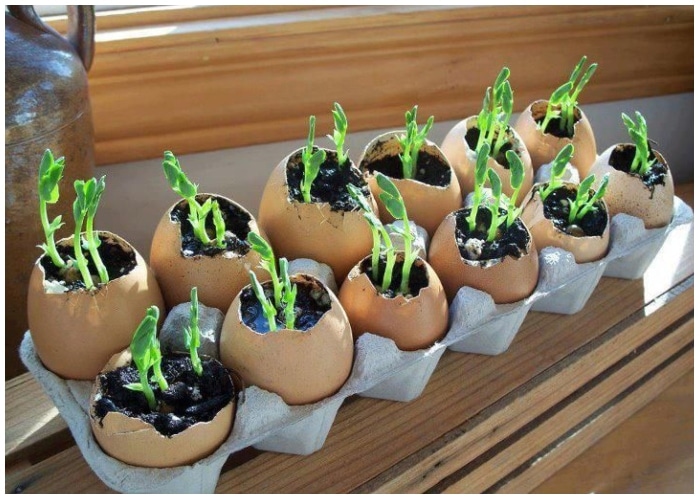 markandhelen
markandhelenThere are numerous advantages to growing seeds directly in eggshells. Calcium carbonate, which is found almost entirely in eggshells, is one of the most important minerals for healthy plants. The eggshells nourish the soil with calcium and nitrogen as they decompose, which the plant’s roots will absorb and utilize as it grows. It is also a smart way to reduce waste.
…Or use an empty cardboard egg carton to start seedlings
Similarly, if the eggs came in a cardboard carton, you don’t need the shells at all—just start the seeds in it. After you’ve used a cardboard egg carton, cut the cups apart, put some fresh soil with the seedling, and plant the whole cup right in the garden’s soil.
 sparklestories.com
sparklestories.comThe cardboard will disintegrate (since it’s biodegradable) and return back to the ground. It’s also a good idea to cut some slits in the cardboard cup’s base to make it easier for the roots to expand as the plant grows. This is another way to upcycle what would be otherwise trash.
Start seedlings in citrus halves
Half-peels from oranges, grapefruits, and other citrus fruits can also be used as seed or propagated plant starter pots. Growing seeds in citrus peels is as environmentally friendly as it gets. You start with a natural substance, grow a beneficial plant in it, and then reuse it as a nourishing composting agent in the ground. It is a win-win situation.
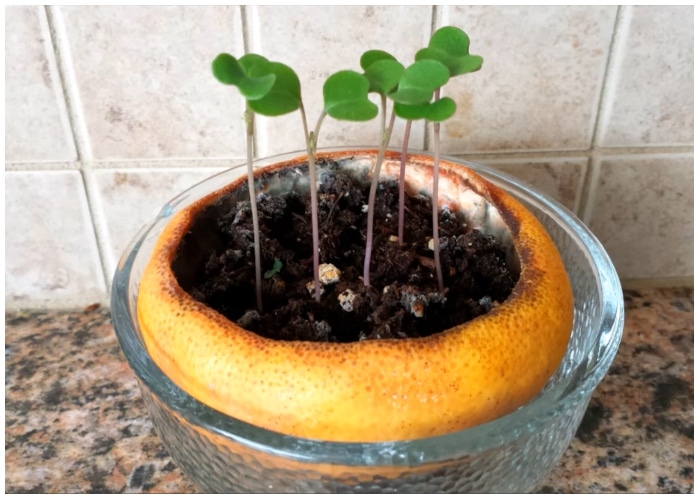 youtube
youtubeGrowing seeds in citrus peels could not be any simpler. First, hollow out the citrus and leave the thick rind. Then, just fill the rind with potting soil either homemade or purchased, add one or two seeds and water in.
Mix some cinnamon into your seedling soil
Fungal infections, also known as “damping off,” kill many seedlings. Cinnamon’s antifungal effects can assist to keep those issues at bay, and it also fertilizes plants. Place a teaspoon of cinnamon on a paper towel and roll damp stem ends in it. Fresh potting soil should be used to plant the stems.
 youtube
youtubeThe cinnamon will promote the stem to generate more roots while also preventing damping-off disease caused by fungus, mites, and whiteflies. Damping off is caused by a fungus or mold that thrive in cool, wet conditions. Fortunately, cinnamon is a common household product and it’s easy to access.
Sprinkle eggshells in the soil
Another technique to add calcium to your soil is to scatter crushed eggshells on it. Pests such as snails and slugs will be repelled by it. Eggshell calcium is also beneficial in garden soil, where it helps to balance soil acidity while also delivering nutrients to plants.
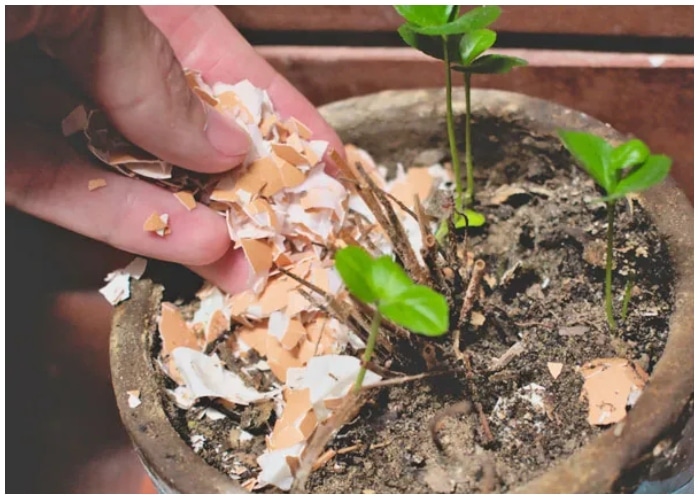 plantindex.com
plantindex.comEggshells have so much calcium in them that they can be utilized practically like lime, albeit you’d need a lot of them to make a noticeable difference. Grind your eggshells into fine powder and mix it with other organic matter at the bottom of a hole in the soil to help plants thrive.
Make propagated plant babies to give as gifts
You will have gifts to give for any occasion if you learn to propagate. Because each plant is different, you will want to look up the name of yours to see if and how you can reproduce it. A professional would propagate plants not only for their own collection, but for the benefit of others as well.
 youtube
youtubeBecause houseplants are such an important part of maintaining a happy and healthy household, be sure to share the love–and your baby plants–with those you care about. To increase their chances of survival, avoid their dormant season. It makes the perfect housewarming gift!
Use the upside-down water bottle trick to water plants while you’re on vacation
Fill a water bottle halfway with water, remove the cap, and turn it upside down and into the soil a few inches deep. The water will be absorbed by the soil over time, keeping it moist. Plant spikes made of clay can also be purchased for better control over picky plants.
 homehacks
homehacksBecause the terracotta spike keeps the soil constantly moist but also doesn’t drown them, it lets you off the hook if you forget about watering, or go out of town for a couple of weeks. As for bottles, you can recycle a glass wine bottle or a plastic one.
…Or try the water-wicking method
While you are gone, the water-wicking method is another way to keep your thirsty plants well watered. Use a cotton rope with one end tucked into the soil of your plant and the other end dangling from the bottom of a water container. The cotton rope will slowly wick water from the container into the pot, maintaining a constant level of moisture in the soil.
 cnet.com
cnet.comYou will be able to go out on vacation without worrying your plants will dry out and without having to bother a friend to come water them weekly. Martha Stewart swears by this watering technique.
Use ice cubes to water your plants
Once a week, place three or more ice cubes on top of the soil and allow the ice to melt and nourish your plants. The advantages: You won’t get a leak, it will keep you from overwatering, and it will keep fragile foliage (like African violet leaves) from becoming wet. It is also a lot simpler to water hanging plants with it.
 blog.nurserylive.com
blog.nurserylive.comThe downside of this technique: Because cold water can shock the roots of tropical plants, this suggestion should probably only be used on holidays. Orchids are special plants that require special care, and they like ice cube watering.
Add your used coffee grounds to soil
After enjoying your coffee, rinse your used coffee grounds and rake a small amount into your plants’ topsoil. Alternatively, use them without rinsing to give an acidic boost to plants that like a lower pH, such as blueberries, maidenhair ferns, and azaleas. Some pests will be deterred by the coffee, and wanted earthworms will be attracted to the area.
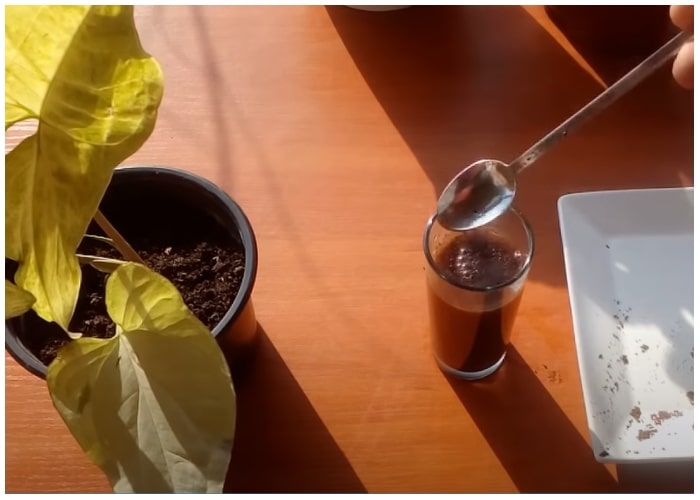 youtube
youtubeEarthworms eat decaying plant material and don’t damage growing plants. They‘re important to soil structure and fertility. Some earthworms emerge at night to feed on dead plant material on the surface, and will pull fallen leaves into their tunnels, aiding fertilization.
Cut open a diaper to help your plants retain moisture
Believe it or not, cheap disposable diapers can keep your potting soil from drying out, especially during warm, dry weather seasons when containers require frequent irrigation. Please be aware that we are talking about fresh, clean diapers. Disposable diapers container hydrogel – that is the same stuff you can buy in gardening stores, usually labeled as “water retention crystals”.
 laidbackgardener
laidbackgardenerFirst, tear open a diaper and dump the contents in a mixing bowl. Then, add water until you have a thick gel, follow mixing in equal parts potting soil. Put the stuff in a pot and now you are ready to plant.
Give your plants drinks of your club soda
Plants need minerals like phosphorus, potassium, and sulfur to grow bigger and greener, and club soda contains all of them. Plants that are fed carbonated water over a length of time will develop faster than those that are fed plain tap water.
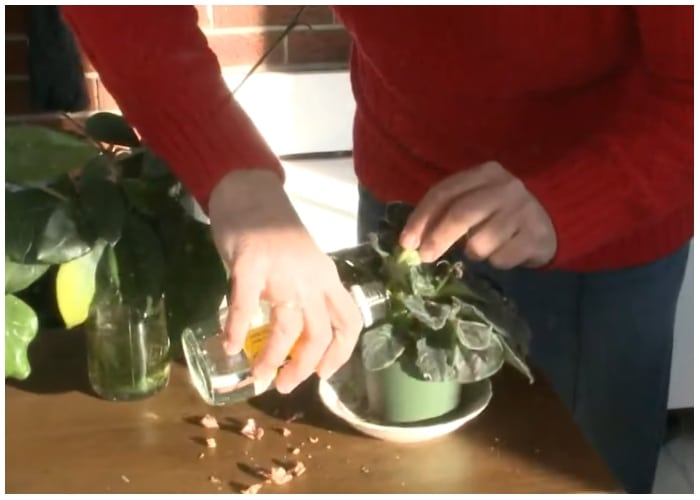 youtube
youtubeMost plants acquire nutrients dissolved in water via their roots, and macronutrients can be found in carbonated water. Carbon, oxygen, hydrogen, phosphorus, potassium, sulfur, and sodium are the macronutrients in question. So, if you have some money to spare, invest in club soda and test it for 10 days. You will see how stronger and greener they become.
Add cat litter to your soil mix for succulents and cacti
Cacti and succulents prefer a soil that drains quickly. You can buy it at the supermarket or make your own by combining half regular soil and half cat litter—just make sure the litter is unscented and clay-based. By aiding with drainage, kitty litter can provide an essential component that cacti require to thrive.
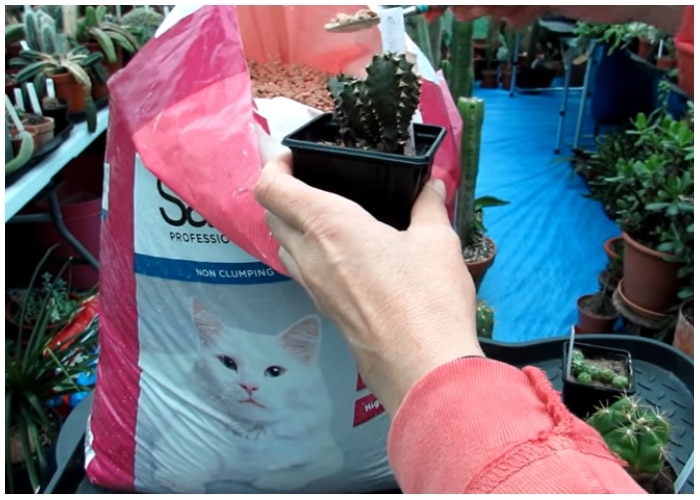 desertplantsofavalon.com
desertplantsofavalon.comSucculents and bulb plants, for example, will perish if they sit in water-soaked soil for too long. Keep in mind that well-draining soil doesn’t just let excess water pass through. For it to be effective, the soil has to create air spaces that give the roots oxygen.
Use honey to root plant cuttings
Dip the stem in honey before placing it in soil to prevent it from fungal or bacterial problems while trying to root a new plant from a cutting. Honey is a common household item that also happens to contain enzymes for promoting root growth in plants.
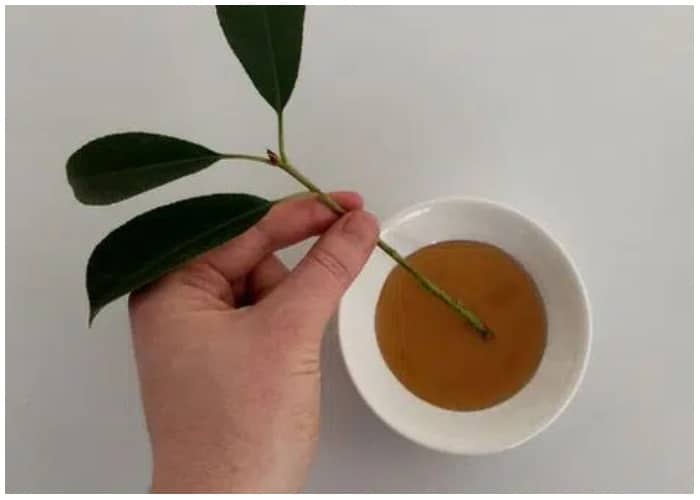 balconygardenweb.com
balconygardenweb.comHoney is, after all, a natural antiseptic with antifungal characteristics, which is thought to be one of the reasons honey works so effectively as a root hormone. In fact, one tablespoon (15 mL) of honey contains 17 grams of carbohydrates, the majority of which are sugars, and appears to provide plants a much-needed boost.
Use water from boiling vegetables to water your plants
Here is another way to water your plants that’s both inexpensive and effective. To give your plants an extra boost of nourishment, use the cooking water from pasta and veggies. Instead of tossing the water down the drain the next time you make pasta or steam veggies in your kitchen, use it to keep your plants green and flourishing.
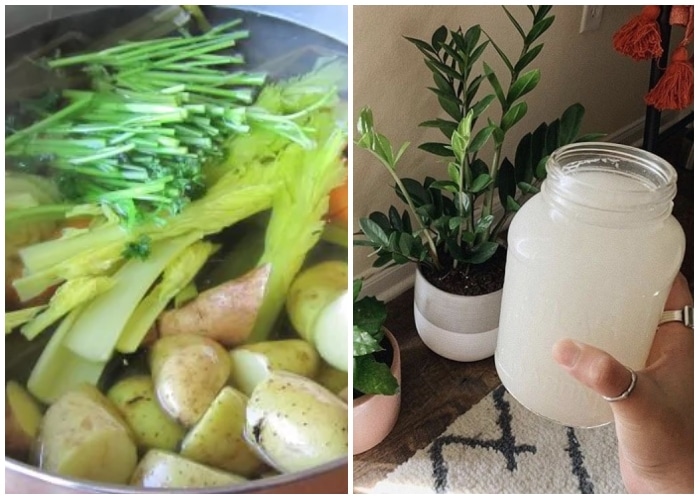
Many micronutrients, such as phosphorus, nitrogen, and calcium, are cooked off into the water when you boil pasta, vegetables, eggs, or potatoes. Allow the water to cool and water your plants with this refreshing drink, that is also a much-needed fertilizer.
Fill large planters with crushed soda cans
Crushed soda cans can aid with drainage, promote air circulation, and save you money on soil. Just make sure they are clean and free of debris before you begin. Use empty aluminum cans to save on potting mix and make large containers lighter.
 binkiesandbriefcases.com
binkiesandbriefcases.comCrush the aluminum cans and place them in the bottom of the pot, and cover them with landscape fabric or screen wire. Then pour in potting soil and place the plant. Pots will drain freely if you accidentally overwater. This is another environmentally friendly way to upcycle soda cans that would otherwise end up in a landfill.
Place a coffee filter in the bottom of your pot
A coffee filter placed between your plant’s dirt and the drainage hole in the pot prevents dirt from spilling out. When water and dirt move out of the hole, the hole can get plugged, limiting water flow. This might cause root rot; fatal to your plant.
 amazingcreation
amazingcreationNot only that, but the filth that is washed away with the water creates a mess. To avoid these issues, some people put rocks at the bottom of their pots, but a coffee filter is much easier. Water and air will be able to flow freely, and dirt will be kept neatly in place.
…Or use a drill to add drainage holes to a pot without them
Plants benefit greatly from appropriate drainage. If you have a cute planter that doesn’t drain, you can add drainage holes to it. Drill plastic pots with a standard drill bit, stone or terracotta with a masonry drill bit, or glazed ceramics using diamond tipped bits.
 youtube
youtubeMake a smallstarter’ mark with your nail where you want the drainage hole. Slowly work with your spray bottle in one hand and your drill in the other. Using the spray bottle, keep the drill bit and the pot surface wet. This prevents the pot from splitting and the bit from overheating and potentially snapping.
Use a banana peel to dust your plants’ leaves
You can also dust your leaves with a banana peel. We tested it and found that it did get rid of the dust, however it did leave some banana muck behind. If you don’t mind the smell (apparently, bananas help repel aphids), it’s a terrific way to recycle your food.
 dvo.com
dvo.comApparently shredded banana peels draped all over plants, can assist to rid it of an aphid infestation, according to an old folk treatment (and some content creators on YouTube). After you are done cleaning the leaves, chop the used banana peels up and toss them in the pot for fertilizer.
Clean your plants with mayonnaise
This is a great technique to add to your list of must-try houseplant hacks. Did you know that mayonnaise makes the leaves of your plants shine? When leaves become dusty, they lose their shine and are unable to properly photosynthesize. Using a rag, dab a small amount of mayonnaise on the plant leaf and gently wipe it away.
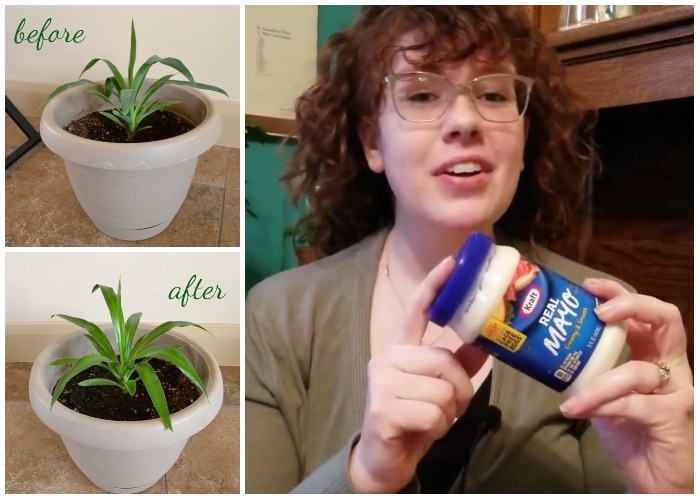 wonderhowto.com / youtube
wonderhowto.com / youtubeYou will be pleasantly surprised at how healthy and lustrous your foliage becomes. Do this every once a month or when you see dust or gunk starting to collect on the plant’s leaves. Mayo is another household product that has various uses.














